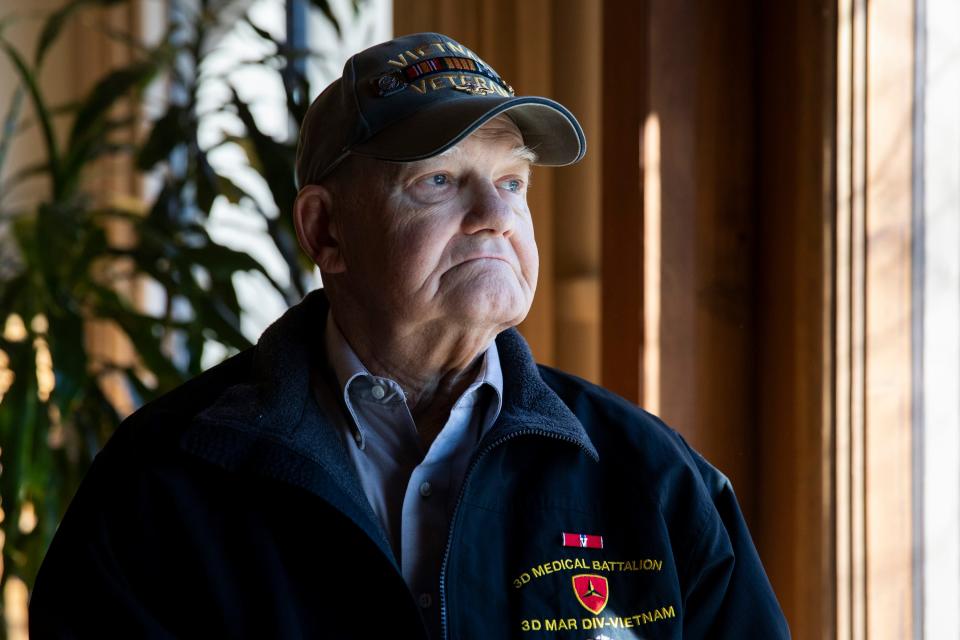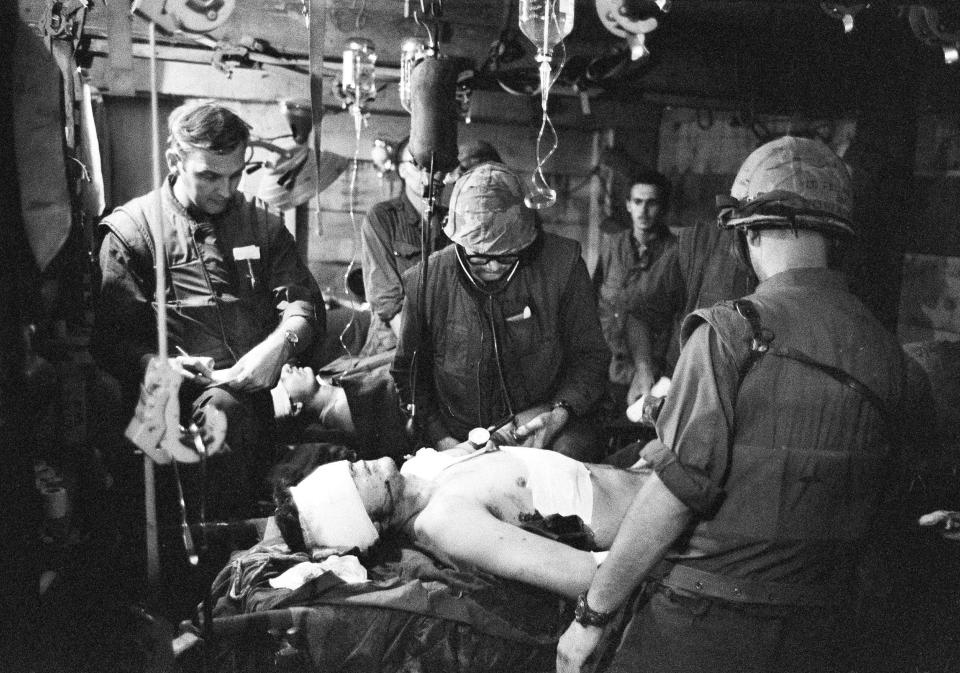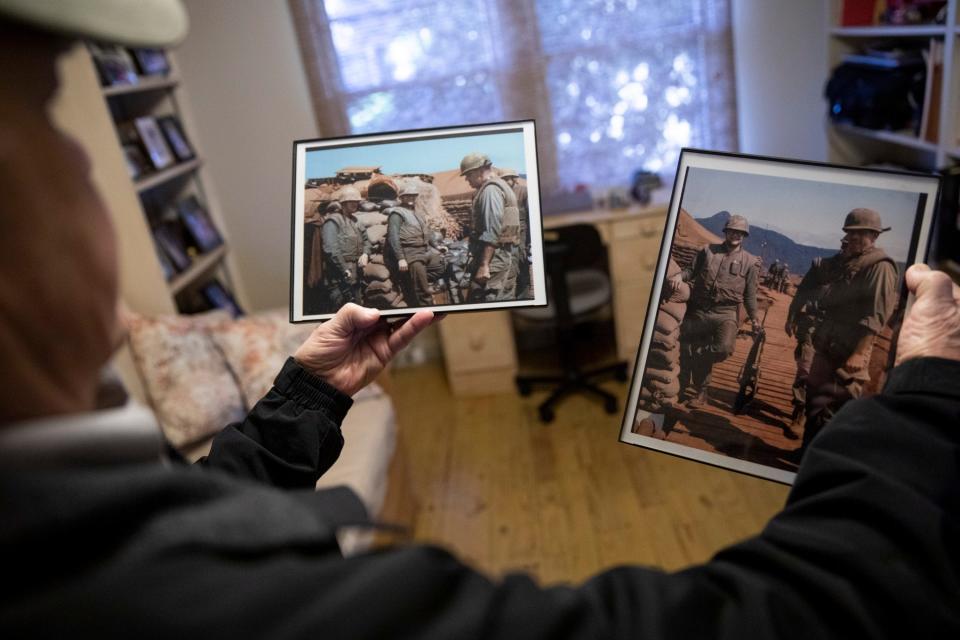Meet the Vietnam War doctor who helped treat more than 2,500 men during multi-month siege
- Oops!Something went wrong.Please try again later.
Editor’s Note: This article is a part of the USA TODAY Network’s series Vietnam War: Remembering the sacrifices of many. As the nation celebrates Memorial Day, a federal holiday centered around honoring those who lost their lives defending America, we tracked down a living Vietnam War veteran whose heroics were captured in still photos.
Dr. Joe Wolfe learned the hard way not to argue with your commanding officer.
When he disagreed about a treatment, the CO sent Wolfe into the bloodiest siege of the Vietnam War. The plane dropping him off at the base in Khe Sanh didn’t even stop. Wolfe had to jump off the tailgate.
“I didn’t see any other living person," he said. "It was the most lonely I’ve ever felt in my entire life."
The base was surrounded by North Vietnamese soldiers who aimed right in. An average of 1,700 rounds per day came through the fences, into the base. Wolfe learned quickly that when you heard the heavy artillery from Co Roc mountain, you had 12 seconds to get under cover. You counted the booms, then counted the impacts to make sure all the bombs exploded.
Wolfe had finished medical school and one year of general-surgery residency, intending to become a urologist. His three fellow general medical officers were about as inexperienced — one had completed a year of ob/gyn training. “We were cannon fodder," he said. "We were expendable."

It was Wolfe, the three other doctors and about two dozen support staff. At first, they worked in triage tents surrounded by 4-foot-high walls. Shrapnel flew in over the walls, shattering glass IV bottles, so they put patients on the floor. The medical team worked in an assembly line, crawling next to patients, sweeping shards out of the way.
Soon they moved the triage center into bunkers. For his first two months, there were no showers. Everything smelled like blood and epinephrine.

Their job: assess, treat and stabilize. There was a rhythm to it. Find all the points of injury. Clean the shrapnel wounds, cutting away tissue to get the fragments out. Insert a chest tube if needed so the soldier could breathe. Thread a catheter from a man's leg vein through the pelvis into the vena cava — the fastest way to get blood into the bleeding body.
“You did what you had to,” Wolfe said.
Even heart surgery. One of their stretcher-bearers, a conscientious objector, broke a cardinal rule while loading men into a helicopter: He left his flak jacket open. After the shots sounded, he told Wolfe, “I’m fine — go check on someone else.”

He wasn’t fine. He’d been hit in the chest. When the doctors cut open the stretcher-bearer's chest, they saw a tear in the tip of his left ventricle--the lower chamber of the heart. Like tying a balloon, one of Wolfe’s colleagues put his finger on the hole, and another stitched around it.
The man survived for a week. He died of infection in a hospital in Japan.
But he was in the minority. When the siege let up, Wolfe and his colleagues had treated more than 2,500 men and medevac’d out 2,300, according to a log book. Of those evacuated, Wolfe estimated, 80% to 90% lived.
Going in, Wolfe had considered changing his specialty to cardiology. Coming out, he stayed in urology.
“I decided I’d seen all the trauma I wanted to see,” he said.
The four medical officers were awarded the Bronze Star, Wolfe said. “With a combat V on it, to show you’ve been in combat. And we were.”
How we located Wolfe, Paul Longgrear and James Cook: To find subjects for this project, we began with the photos. We combed through the Associated Press archives, the Library of Congress, Getty, the National Archives and the U.S. Department of Defense Flickr collection, among other photo collections, looking for historic moments, visually striking shots, Southern residents, women and Black veterans.
Where the subjects in the photo were bylined, we checked a range of directories, including Google, Ancestry’s Military Records collection, Lexis-Nexis public records, Together We Served, Legacy and Facebook, using a variety of spellings. We put out the word to various veterans’ groups and historians for specific military divisions and operations, prisoners of war, the U.S. Army Heritage and Education Center and Operation Homecoming.
In the end, we were able to track down three living veterans. If you know anything about Lt. AL Walker, please let us know.
Danielle Dreilinger is an American South storytelling reporter and the author of the book “The Secret History of Home Economics.” You can reach her at ddreilinger@gannett.com or 919/236-3141.
This article originally appeared on The American South: Vietnam War doctor helped 2,500 men during siege, 'you did what you had to'

